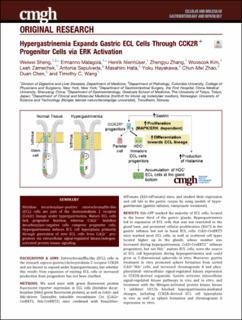| dc.contributor.author | Sheng, Weiwei | |
| dc.contributor.author | Ermanno, Malagola, | |
| dc.contributor.author | Henrik, Nienhüser | |
| dc.contributor.author | Zhengyu, Zhang | |
| dc.contributor.author | Woosook, Kim | |
| dc.contributor.author | Leah, Zamechek | |
| dc.contributor.author | Antonia, Sepulveda | |
| dc.contributor.author | Masahiro, Hata | |
| dc.contributor.author | Yoku, Hayakawa | |
| dc.contributor.author | Zhao, Chun-Mei | |
| dc.contributor.author | Chen, Duan | |
| dc.contributor.author | Timothy C., Wang | |
| dc.date.accessioned | 2022-05-05T14:55:30Z | |
| dc.date.available | 2022-05-05T14:55:30Z | |
| dc.date.created | 2020-08-31T15:04:05Z | |
| dc.date.issued | 2020 | |
| dc.identifier.citation | Cellular and Molecular Gastroenterology and Hepatology (CMGH). 2020, 10 (2), 434-449. | en_US |
| dc.identifier.issn | 2352-345X | |
| dc.identifier.uri | https://hdl.handle.net/11250/2994420 | |
| dc.description.abstract | Background & Aims
Enterochromaffin-like (ECL) cells in the stomach express gastrin/cholecystokinin 2 receptor CCK2R and are known to expand under hypergastrinemia, but whether this results from expansion of existing ECL cells or increased production from progenitors has not been clarified.
Methods
We used mice with green fluorescent protein fluorescent reporter expression in ECL cells (histidine decarboxylase [Hdc]-green fluorescent protein), as well as Cck2r- and Hdc-driven Tamoxifen inducible recombinase Cre (Cck2r-CreERT2, Hdc-CreERT2) mice combined with Rosa26Sor-tdTomato (R26-tdTomato) mice, and studied their expression and cell fate in the gastric corpus by using models of hypergastrinemia (gastrin infusion, omeprazole treatment).
Results
Hdc-GFP marked the majority of ECL cells, located in the lower third of the gastric glands. Hypergastrinemia led to expansion of ECL cells that was not restricted to the gland base, and promoted cellular proliferation (Ki67) in the gastric isthmus but not in basal ECL cells. Cck2r-CreERT2 mice marked most ECL cells, as well as scattered cell types located higher up in the glands, whose number was increased during hypergastrinemia. Cck2r-CreERT2+ isthmus progenitors, but not Hdc+ mature ECL cells, were the source of ECL cell hyperplasia during hypergastrinemia and could grow as 3-dimensional spheroids in vitro. Moreover, gastrin treatment in vitro promoted sphere formation from sorted Cck2r+Hdc- cells, and increased chromogranin A and phosphorylated- extracellular signal-regulated kinase expression in CCK2R-derived organoids. Gastrin activates extracellular signal-regulated kinase pathways in vivo and in vitro, and treatment with the Mitogen-activated protein kinase kinase 1 inhibitor U0126 blocked hypergastrinemia-mediated changes, including CCK2R-derived ECL cell hyperplasia in vivo as well as sphere formation and chromogranin A expression in vitro.
Conclusions
We show here that hypergastrinemia induces ECL cell hyperplasia that is derived primarily from CCK2R+ progenitors in the corpus. Gastrin-dependent function of CCK2R+ progenitors is regulated by the extracellular signal-regulated kinase pathway. | en_US |
| dc.language.iso | eng | en_US |
| dc.publisher | Elsevier | en_US |
| dc.rights | Attribution-NonCommercial-NoDerivatives 4.0 Internasjonal | * |
| dc.rights.uri | http://creativecommons.org/licenses/by-nc-nd/4.0/deed.no | * |
| dc.title | Hypergastrinemia Expands Gastric ECL Cells Through CCK2R Progenitor Cells via ERK Activation | en_US |
| dc.title.alternative | Hypergastrinemia Expands Gastric ECL Cells Through CCK2R Progenitor Cells via ERK Activation | en_US |
| dc.type | Peer reviewed | en_US |
| dc.type | Journal article | en_US |
| dc.description.version | publishedVersion | en_US |
| dc.source.pagenumber | 434-449 | en_US |
| dc.source.volume | 10 | en_US |
| dc.source.journal | Cellular and Molecular Gastroenterology and Hepatology (CMGH) | en_US |
| dc.source.issue | 2 | en_US |
| dc.identifier.doi | 10.1016/j.jcmgh.2020.04.008 | |
| dc.identifier.cristin | 1826282 | |
| cristin.ispublished | true | |
| cristin.fulltext | original | |
| cristin.qualitycode | 1 | |

